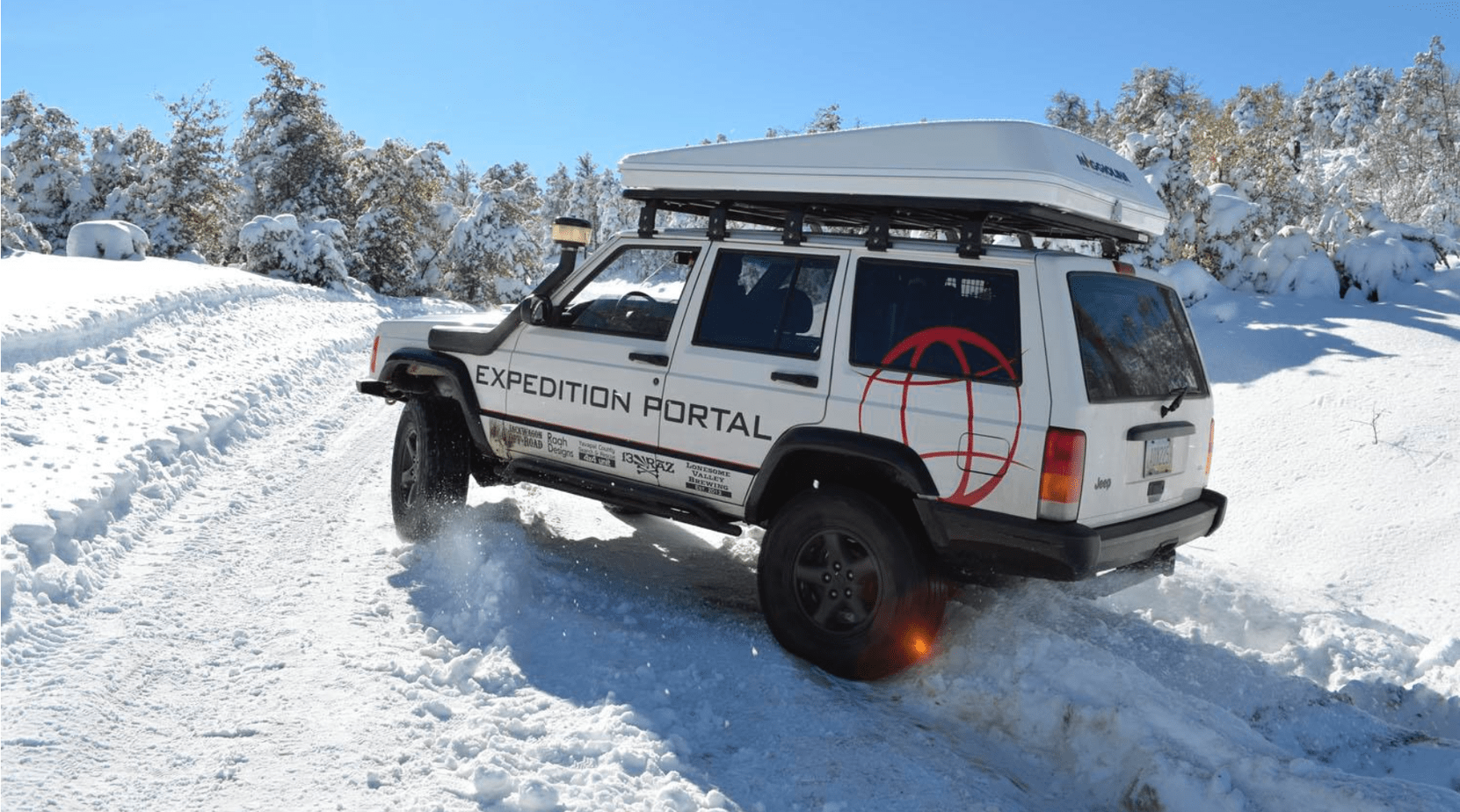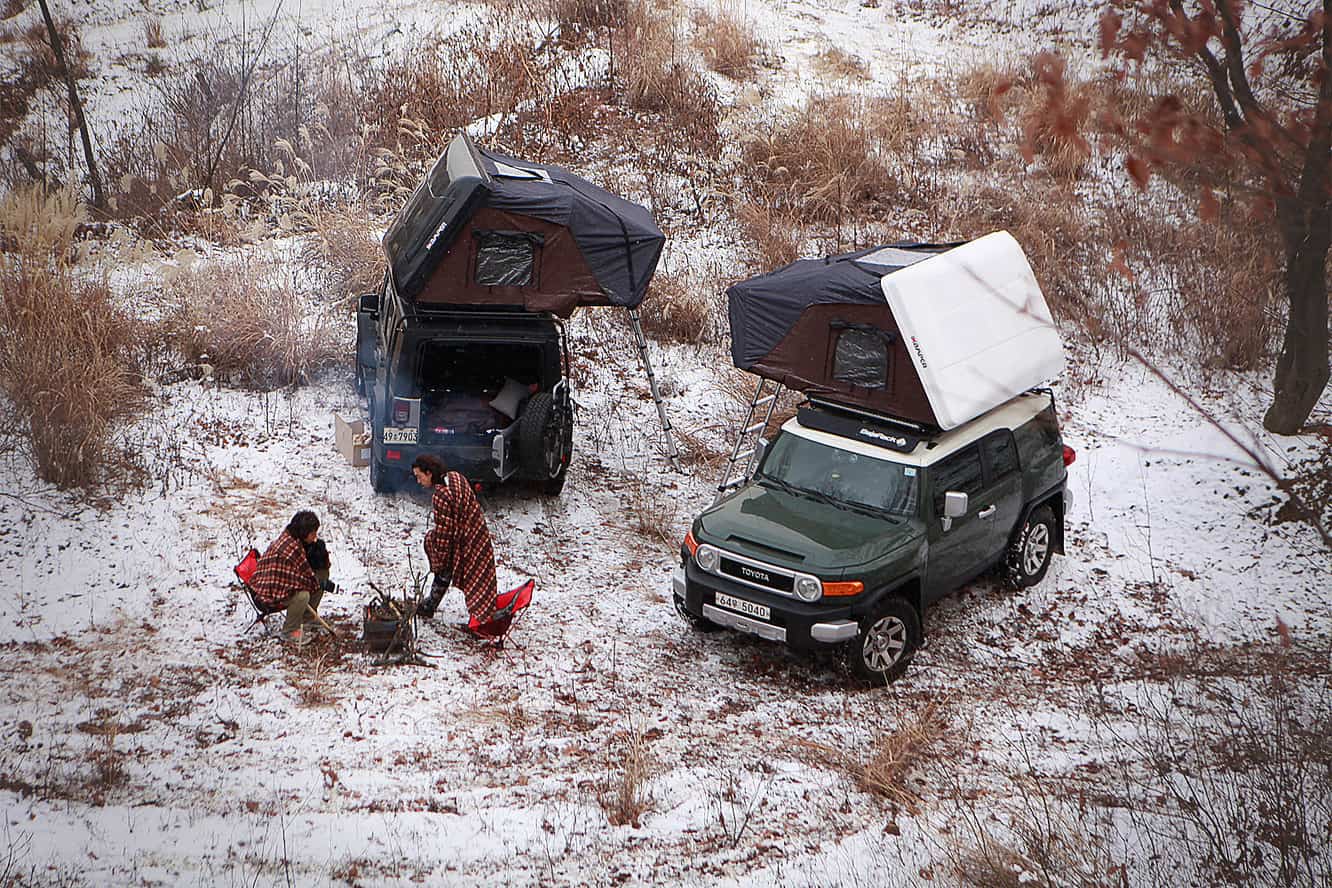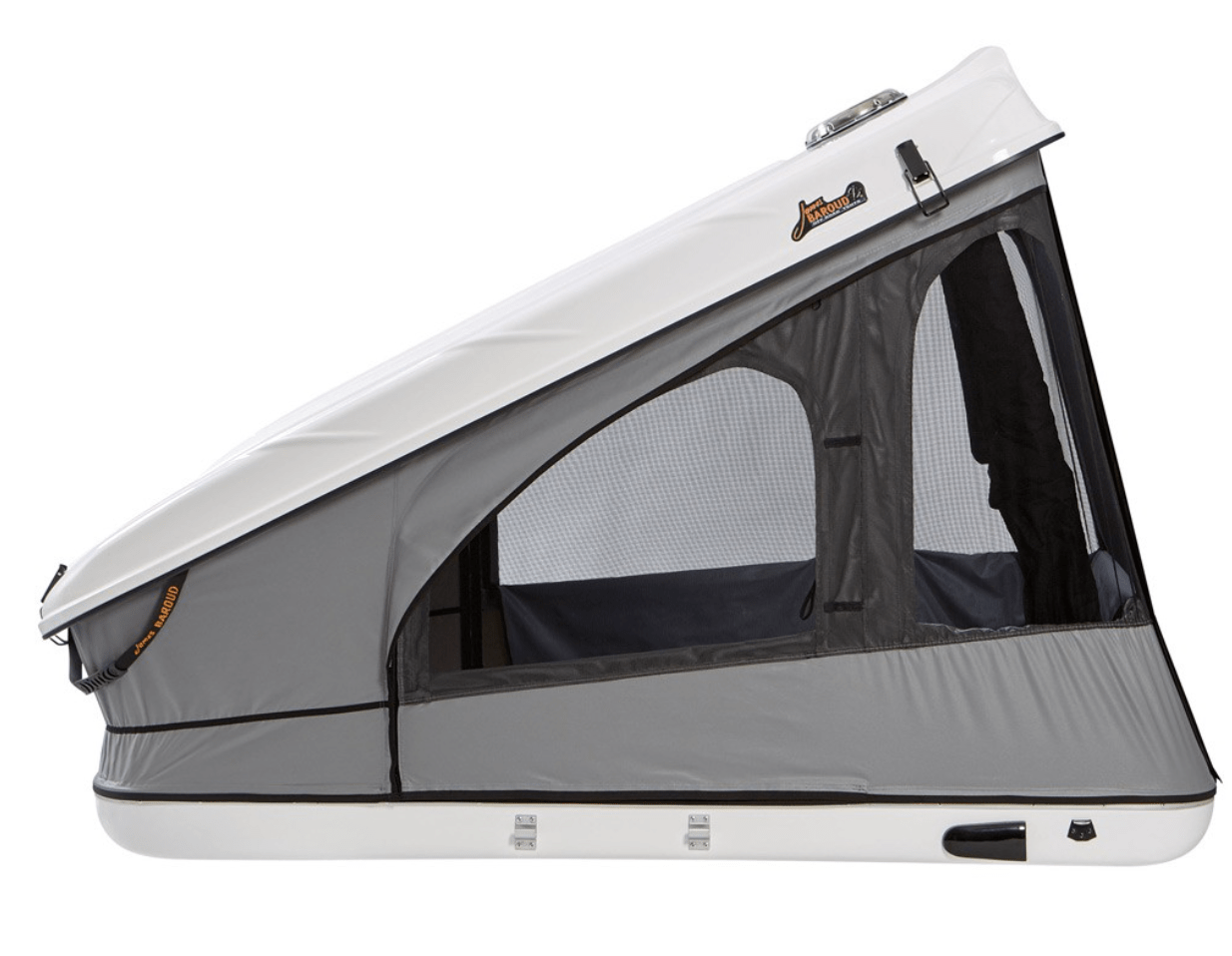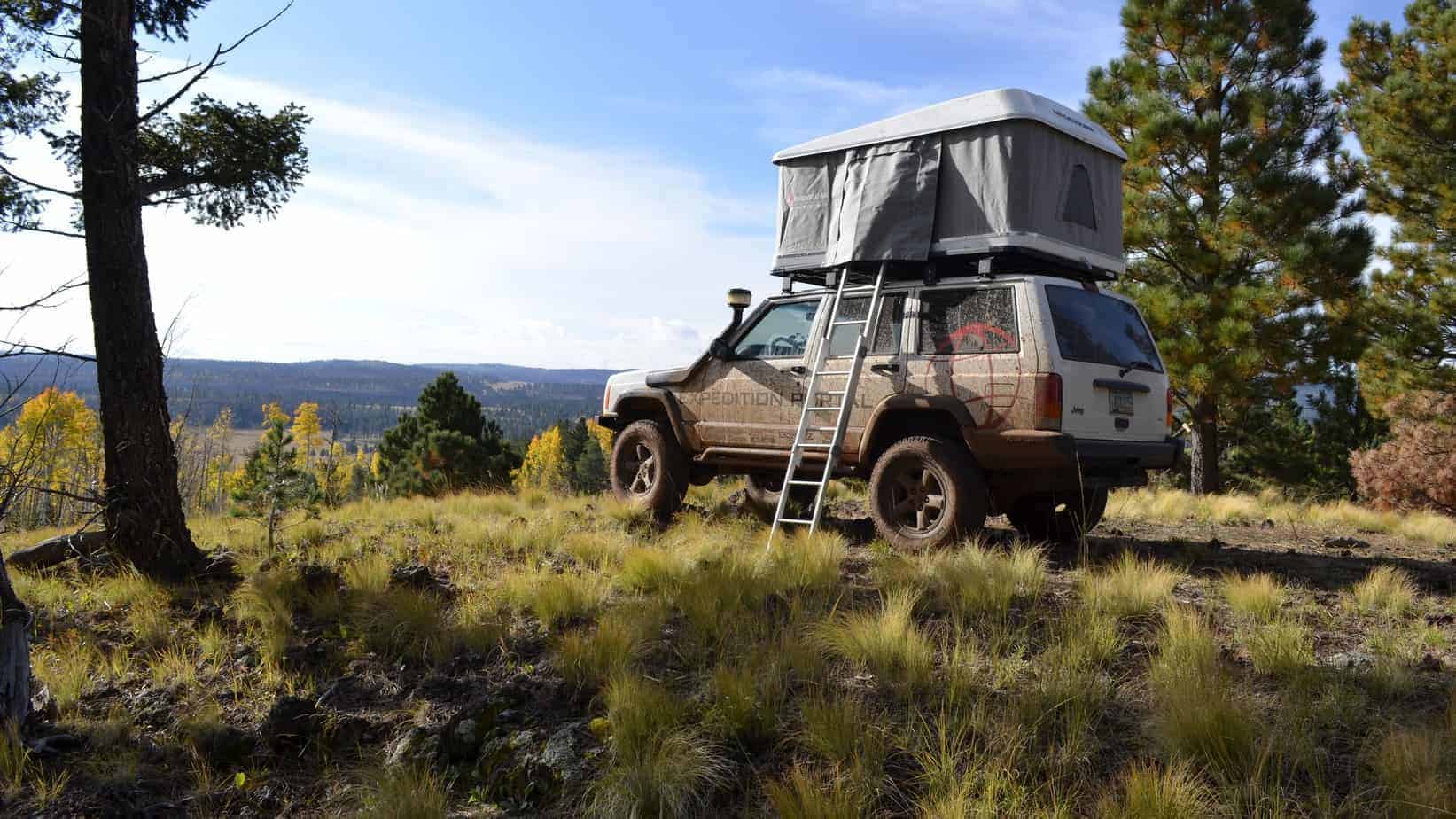This article was updated on 06 December 2023
The roof top tent has become an omni-present fixture 0f the overlanding world. As such, we have published dozens of reviews and op-eds espousing the benefits of truck-top sleeping as well as comparative thoughts on soft-sided tents versus their hard shelled counterparts. Without rehashing that debate yet again, let’s dive into the reasons why any overlander would opt for the hard shell.
Anyone with any soft shell tent experience knows the frustration endured by something as simple as a cover. Always dirty and hard to reach, the hard shell doesn’t require a soft cover and as such, eliminates one entire phase of set up or take down. The other main advantage of the hard shell is the ease of use. Many employ gas-charged struts and can open themselves with the release of a single buckle or be raised with the push of a button. In our extensive testing of various leading tents, the Autohome Columbus is the quickest pitch. With one hand and as few as 60 seconds the tent can be ready for two tired sleepers.

Although many soft-sided tents have proven extremely durable, the cases encapsulating hard shell tents won’t tear, fade, or weather nearly as badly as their fabric cousins. They are susceptible to cracks and damage if impacted, but can also be repaired in most cases. The last major perk of the hard shell tent is relative to aerodynamics. Most folding tents are shaped like the proverbial brick whereas many hard shells are sleek and slippery. They also compliment the aesthetics of modern vehicles a tad better than the ungainly box shape of a soft tent.
If you read through our soft shell tent buyer’s guide, you likely noticed a massive selection of tents currently being peddled by vendors new and old. Some of them are clearly fly-by-night operations while others are innovators and legends of storied reputation. The hard shell market is considerably different. There are fewer players and products to sort through. While we have not tested all of them, our team at Overland International has spent countless nights in most of them. This guide is not intended to be a review of products but rather a primer of what is currently available. Where applicable, links to actual reviews compiled by our team have been made available.
Alu-Cab
Based in Cape Town, South Africa, the Alu-Cab Expedition Tent displays the rugged build qualities we would expect of a product from that part of the world. South Africans tend to overbuild and Alu-Cab is no exception. With a welded aluminum upper and lower casing, the shell of the Expedition Tent is more than just a shelter, t is in many ways an extension of the very roof rack on which it usually sits. With the additional slotted rack rails, the top of the tent can be fitted with mounts to haul extra gear, a spare tire, kayaks, bikes, and other accessories.
Expedition Tent, Generation 3

The 400 gram UV-Resistant rib-lock waterproof canvas has sealed seams and mosquito-net backings to the two side doors and rear entry portal. The shell is insulated with polyethylene foam and a plush 4-inch thick mattress provides optimal sleeping comfort while still allowing ample room for bedding to be closed within the shell. Set up is assisted with gas-charged struts and the rear entrance is protected by a large storm awning. Built for extended expedition use, the latest generation of Alu-Cab’s tent now in it’s third evolution, is available in the USA through OK4wd.com
The Alu-Cab is available in one size, weighs 164 pounds, and sleeps two.
MSRP: $4,400
For a full review of the specs and options, click here: Alu-Cab USA
Autohome
Autohome is another legendary company and touted as the oldest in the segment dating to 1958. Based in Italy, their North American distributor is located in Nevada and has been supplying tents to overlanders for over 16 years. Autohome USA offers a comprehensive variety of tents sold within three distinct model categories: Air Top, Columbus, and Maggiolina. The differences between each model have to do with hinge configuration, material variations, and opening mechanisms. One of the additional features of an Autohome tent is the ability to order select models in a variety of shell and fabric colors to match or compliment your vehicle.
Air Top
 The newest in the Autohome lineup, the Air Top is sold in three sizes, and in two shell colors, black storm or white. The shell is made of reinforced double-wall foam core fiberglass on the bottom half with a fiberglass upper half. The tent fabric is a waterproof ripstop Dralon, a material chosen for its durability and weather resistance. The Air Top’s main attribute is the gas-ram strut system that provides effortless opening with the release of just two buckles. All four models feature dual side doors and a third rear door, as well s a small window at the front of the shelter. Each of the windows and doors are backed with heavy-duty mosquito mesh.
The newest in the Autohome lineup, the Air Top is sold in three sizes, and in two shell colors, black storm or white. The shell is made of reinforced double-wall foam core fiberglass on the bottom half with a fiberglass upper half. The tent fabric is a waterproof ripstop Dralon, a material chosen for its durability and weather resistance. The Air Top’s main attribute is the gas-ram strut system that provides effortless opening with the release of just two buckles. All four models feature dual side doors and a third rear door, as well s a small window at the front of the shelter. Each of the windows and doors are backed with heavy-duty mosquito mesh.
Available sizes: Small, medium and large
MSRP: $4,500
For a full review of the specs and options click here: Autohome Columbus Air Top
Columbus Variant

The Classic wedge shape of the Autohome Columbus has been around for years and represents the most fuss-free setup of almost any tent on the market. With a primary hinge at the front and a single locking hasp at the rear, setup takes all of a few seconds with gas-ram struts automatically lifting the upper shell into position. Available in five sizes, two specifically sized for extra length, there is a Columbus for nearly every user.
The advantage to the wedge shape is two-fold. It not only reduces weight and complexity by only requiring lifting struts and mechanisms at one end, it also creates a taller peak. For people with longer torsos, which requires additional headroom when sitting upright, the wedge shape affords that extra space.
All five sizes within the Columbus line share the same features and architecture with two side doors and an oversized rear door. All are backed with mosquito netting and clear plastic windows to let natural light into the interior. The lightest of the five weighs only 114 pounds and the largest, ostensibly capable of sleeping a family with two small children, still only weighs 141 pounds.
Available sizes: Small, Small XL (extra long), Medium, Medium XL (extra long), and Large
MSRP: $4,900
For a full review of the Autohome as penned by our own Chris Collard, click on the image below:
Autohome Columbus Variant: Home Away From Home
Columbus Variant Carbon Fiber

Both the Small and Medium sizes of the Columbus Variant are also offered with carbon fiber upper and lower shells. For the small, it reduces the weight to a paltry 90 pounds and just 103 for the medium.
For more specs and details visit: Columbus Variant Carbon Fiber
Maggiolina AirLand Plus

The AirLand Plus was designed to be as low profile and aerodynamic as possible. With the same vertical walls as the Air Top, it uses a crank-assist opening mechanism to raise the upper shell. This allows for the side walls to be tightened to resist wind gusts up to 50mph. The Airland also features additional insulation for sound deadening and to help moderate internal temperatures in either hot or cold weather. Like the Columbus Variant, the AirLand Plus is available in a selection of fabric colors in all but the extra length sizes.
Available sizes: Small, Small XL (extra long), Medium, Medium XL (extra long), and Large
MSRP: From $4,850
For more specs and details visit: Autohome AirLand Plus
Maggiolina Extreme

The Extreme is built for extended expedition use and is made of heavier shell fabrics than used in the Columbus Variant. The main call-out to the Extreme is the reinforced roof fitted with adjustable roof rack bars. The perfect landing pad for surf boards, bikes, skis, and other accessories, the Extreme’s rack is a popular feature for today’s active overlanders. There are applications where gas-ram struts are not preferred and for those occasions, there are tents like the Extreme which employ a manual crank to raise and lower the upper half. This is particularly important if that upper shell is weighted down with additional gear.
Available in two sizes: Small and medium
MSRP: From $5,120
For more specs and details visit: Autohome Maggiolina Extreme
For a full review of the maggiolina Extreme, click on the image below.
Living with the Maggiolina Extreme Tent, by Chris Ramm.
Maggiolina Grand Tour

The Grand Tour has been in the Maggiolina lineup for many years and offers users additional headroom over other tents in the catalog. It is their top offering with all the bells and whistles including pre-drilled holes and reinforcements which permit an optional roof rack mounting system like those sold by Thule, Yakima, and others. This allows users to add their own full width crossbars. For those inclined to carry boats, bikes, or other equipment, the Grand Tour has that capacity. Like the Extreme, the strong manual crank mechanisms are capable of lifting heavier loads during setup and breakdown. As is the case with several tents in the Autohome catalog, the Grand Tour is available in two shell colors and multiple fabric colors. Additional charges apply.
Available sizes: Small and X-Long, Medium and X-Long, and Large and X-Long
MSRP: From $4,600
For more information on specs and options visit: Maggiolina Grand Tour
Bundutec
BunduTop
This is one of the more unique roof top tents we’ve tested, and it has now been in our fleet for over a year. If there is a winner for the easiest set up of all time, this tent earns that accolade with push-button electric assist. That’s right, an electric winch and elaborate system of pulleys and levers not only raises the upper half, but deploys the 360º awning in one fell swoop. The entire process takes less than a minute. As is the case with the Alu-Cab, also of South Africa, the build quality is decidedly robust. With four-sided doors that double as windows, the views from within are impressive although the whole package is rather large and heavy.
Inside the BunduTop is a plush 4-inch thick mattress, insulated roof lining, and accessory lights. We reviewed the BundoTop as part of our test of leading tents in the 2015 Gear Issue of Overland Journal, and again on Expedition Portal just recently.
Available in three sizes: standard, king, and super king.
MSRP: $4,600
For more specs and details visit: Bundutecusa.com
For a full review of the BunduTop, click on the image below and read what Chris Cordes had to say.
First Impression: BunduTop from Bundutec
Eezi-Awn
Stealth
The most celebrated name in soft shell tents finally dove headlong into the hard shell game with a product that looks like it was shot here from outer space. Aptly named the Stealth, it does look remarkably like the fighter jet of the same name. A highly anticipated product many years in the making, it has only recently landed here in North America and is distributed exclusively through Equipt Outfitters in Salt Lake City, Utah.

Made of powder-coated aluminum top and bottom, the Stealth embodies the built it once, build it right ethos that has made Eezi-Awn the benchmark for quality, form, and function. The gas-strut assist opening takes minimal effort and the ladder slides out of its own dedicated slot in the lower section of the tent base.

With dual side doors and an additional door at the back, the Stealth gets excellent ventilation and even comes with an added awning to provide shade and respite from foul weather. The hybrid wedge-shape increases headroom, while also allowing for more space at the foot of the tent. Look for a full review of the Stealth in the coming weeks as Expedition Portal received one of the first samples to hit our continent.
Available in one size.
MSRP: $5,300
Find more information at: www.equipt1.com
Read the Expedition Portal announcement here: Gear Scout The Eezi-Awn Stealth
iKamper
Skycamp
Over the past two years we have watched iKamper cut their teeth in the American market hoping to find distributorship and a customer base for their fledgling product. Their Kickstarter campaign, which initially sought $100,000, has blown well past that mark and will likely tip $2,000,000 by the time you read this.

The innovative attribute of the Skycamp tent is the expanding platform that increases the sleeping area almost by a factor of two. Capable of sleeping up to three adults, iKamper is aiming at the young family camping segment with their big sleeper and we have seen steady improvements from their initial design of just two years ago. As is true for all Kickstarter projects, it’s a bit of a crap-shoot whether or not you’ll get what you paid for, but the project does look far more legit today than it did two years ago.
MSRP From $2,700
Find out more at: www.ikamper.com
James Baroud
Now in their 20th year, James Baroud of Portugal has been designing and manufacturing premium hard and soft shell tents for the most demanding overland purists. Distributed exclusively in North America since 2014 through OK 4WD in New Jersey, they have developed a loyal following in a rather short period of time. Unlike other manufacturers with a limited offering of product, the James Baroud catalog is quite extensive and offers both hard and soft shell tents within a total of six models, some offered in two sizes, all with the option of white, grey, or black shells.
Discovery and Discovery XXL, Extreme and Extreme XXL
The entry point in the James Baroud lineup, the Discovery is also the least complex of the tents on offer. With a single hinge and a wedge shaped architecture it uses gas-ram strut assisted opening. The Discovery also has three doors and 180º mesh windows for maximum air pass-through. Like all of their tents, it includes a solar powered ventilation fan, internal LED light, and side vents designed to help dispel any internal moisture while in transit. With only two side latches to be unfastened prior to deployment, the Discovery can be fully assembled and sleep-ready in a matter of a minute or two, including the installation of the ladder.

The Extreme is identical to the Discovery series with the exception of an additional cargo recess located in the upper shell for storing additional gear items.
The Discovery is available in standard two-person or three-person XL sizes.
MSRP from $4,500 depending on size and color options.
For more specs and details visit: James Baroud Discovery
Space and Space XXL
The Space is nearly identical to the Discovery in terms of feature, space, and ventilation, but it adds another lifting mechanism at the forward end to increase livable space. Some users find the traditional wedge shape reduces foot space so, the extra 13-inches of room at the lower end of the Space remedies that concern.

Available in two sizes ranging in price from $4,700.
For more specs and details visit: James Baroud Space and Space XXL
Evasion and Evasion XXL
With similar features and options with the Space, the Evasion tents offer a horizontal roof, 360º ventilation with dual side doors, a large rear door, and a full mesh panel along the front wall for maximum air circulation. The Evasion has all of the features of the other tents with a solar fan, aluminum ladder, LED lighting, cargo netting on the roof, and gas assisted opening.

Available in two sizes with prices ranging between $4,700.
For more specs and details visit: James Baroud Evasion and Evasion XXL
Explorer and Grand Raid
These two tents of different name are actually the same, only different in size. The Explorer is the smaller of the two and the Grand Raid the larger capable of sleeping three adults. Both are identical to the Evasion tents with the same features and function, but have additional cargo carrying capacity on the roof in the deep recess of the cargo well. The gas-assist struts have been modified to support those additional loads as well.

The Grand Raid can sleep between two or three adults.
Prices for the Grand Raid range from $4,700
For more specs and details visit: Grand Raid

Roost Tents
The Roost tent is unique in that it is not only marketed as a sleeping shelter, but also as a cargo hauler. Designed to permit the removal of the 2-inch thick mattress and tent walls, the fiberglass shell with gas-strut assisted opening mechanism can be used on its own and provides cavernous amounts of gear toting capacity. It has locking latches to secure your items within, and the tent body includes two side doors and a rear entry panel. For those with a desire to color-match the Roost with their vehicle, the tent shell is available in black or white with four choices of tent colors, six counting two different camouflage patterns. Patriotic buyers will be pleased to know the Roost is made in the USA.

The Roost is available in one size capable of sleeping two adults with an MSRP starting at $3,000
For more specs and details visit: Roost Tents







One Comment
Femke Groot
January 31st, 2019 at 12:24 amHi there,
Great site and good to see “all” information about hardshell RTT’s together on one page.
Just wonderring if we as a Dutch based producer of hardshell RTT’s could be added somehow to your site. Please check our site femkesrooftoptents.com. We are currently updating the information on our site and adding our 3rd type which we call Khosi.
Hope to hear from you. By the way say hi to Michael Bradley whom we met at the DIMA 4×4 in Lommel, Belgium last November.
Kind regards
Femke and Tim